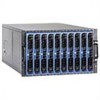Dell PowerEdge 1855 Avocent Digital Access KVM Module Installation Informati - Page 7
General System Configuration - blade server
 |
View all Dell PowerEdge 1855 manuals
Add to My Manuals
Save this manual to your list of manuals |
Page 7 highlights
General System Configuration This guide provides information on configuring your system and the server modules in your system. Additional information is available from additional sources. See "Other Documents You May Need." Your system can include up to ten server modules (also known as "blades"). See Figure 1-1. Each server module functions as an individual server encompassing up to two microprocessors, up to two hard drives, and up to six memory modules. NOTE: To ensure proper operation and cooling, all server module bays must be populated at all times with either a module or with a blank. Figure 1-1. System Front View 1 2 3 4 5 6 7 8 9 10 server modules (10) To function as a system, a server module is inserted into a chassis that supports power supplies, fan modules, a management module (Dell™ Remote Access Controller/Modular Chassis [DRAC/MC]), a keyboard/video/mouse (KVM) switch module, and at least one I/O module for network connectivity (see Figure 1-2.) The power supplies, fans, DRAC/MC, and I/O modules are shared resources for the server modules in the chassis. In addition, your system may also ship with an optional external USB diskette drive and an optional external USB CD drive, which you can use to set up and configure the server modules. General System Configuration 5















